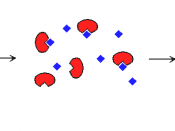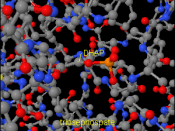*Metabolism:Term used to describe chemical reactions in a cell.
*Reactants:Chemicals that react with each other.
*Products:Chemicals produced at the end of a chemical reaction.
*Anabolic reaction:Reactions that involve the building up of complex molecules from simpler molecules. Enery is required. e.g photosynthesis*Catabolic reaction: Reactions where complex molecules are broken down into simpler molecules. These reactions realease energy.e.g respiration*Enzymes: Catalysts(proteins) which speed up chemical reactions without getting envolved in them.
-enzymes control metabolic reactions.
-They are proteins.
-Proteins are made up of long chains of amino acids, that fold over and take up a specific shape.
-Enzymes will only work if they have the correct shape to allow them to function properly.
*substrate:Substance an enzyme reacts with.
^^pH^^-Tends to change the shape of the enzyme and effect the rate an enzyme will carry out its function.
-Enzymes will only have its correct shape at a specific pH.
-The enzyme becomes less efficent on the other side of the pH.
^^Temperature^^-At low temp cell contents become solid, so enzymes cannot work.
-As temp increases so does rate of reaction because the substrate and enzyme get more energy.
-The temp that an enzyme works beast at is its optimum temp.
-above optimum temp enzymes denature and rate of reaction drops.
__________________________________*Immobilised Enzymes: Enzymes that are attached to eachother or an inert material.
Advantages of immobilised enzymes-Can recover enzymes easily- Enzymes can be reused-effiency of enzymes is not affected*Bioreactor-Large tank containing enzymes in an immobilised form used in industrial processes.
________________________________________*Active site- The part of the enzyme taht combines with the substrate.
Active Site Theory1.The substrate combines wih the active site of the enzyme.
2.The active site is induced slightly to make a better fit for the substrate.
3. The bonds in the substrate are altered...


